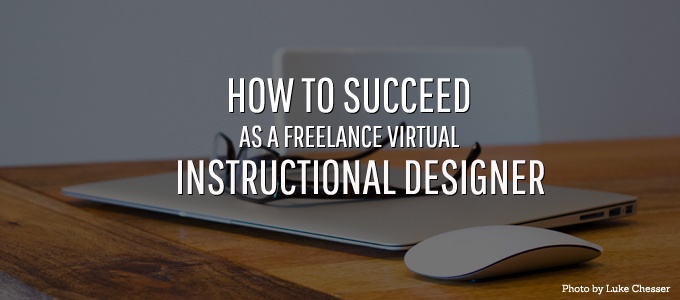Succeed as a Virtual Instructional Design Freelancer: 7 Best Practices for Conducting Yourself on the Job
In part 1 of this series, I shared eight tips for landing freelance virtual instructional design (ID) projects. Now in part 2, let’s take a closer look at the way you conduct yourself once you’re assigned to a project team.
If you’re used to working in an office where your manager or team members can lean over and ask a question, or observe your focused working style, you likely need to make some adjustments to be a successful virtual ID freelancer. I've seen how the best-of-the-best freelance virtual instructional designers become highly valued players on my team, and I’d like to share their best practices with you.
Once you land a project, you want to be seen as a highly sought-after, superstar instructional designer. You want to ensure you are reliable and skilled, while continuing to build your relationship with your client. Don’t underestimate how important positive behaviors are in building your career and work pipeline. Master them, and your clients will surely remember you for their next projects. And aside from getting more work, repeat business with the same client is often easier on you, since you already understand their work style, culture, and processes.
How to Be a Successful Freelance Virtual Instructional Designer: 7 Best Practices for Conducting Yourself on the Job
#1. Keep a shared calendar so people know when you are available during the typical 8 to 5 workday.
Share your calendar and allow anyone on your team to set up time with you during designated periods. In Google Calendar™, you can adjust your settings so team members only see your time as busy or available, and not all details about your scheduled appointments.
#2. Communicate regularly via email.
Response within a couple of hours is best, even if it is to acknowledge the email and an estimated time to reply. In a virtual environment, email is typically the main form of communication. IDs who “go dark” via email are seen as unreliable and are likely to not be engaged for future projects.
#3. Ask for help.
Lead instructional designers (LIDs) or managers may offer iterative reviews on your deliverables, such as your first detailed design document or storyboard. Take them up on their offer. If they don’t offer it, request it. Your proactive mindset puts you in a very positive light, shows you are open to feedback, and ensures you are on the right track with a deliverable that is in process. Using this approach, you avoid a lot of extra rework if you complete the entire deliverable off track from what the lead ID was anticipating.
#4. Ask for samples of similar projects.
Start with the guidance gained by reviewing previous courses, but don’t just stay in the same box. Get creative. Add something extra to continue to improve the approach (within budget, of course!).
#5. Have a can-do attitude.
Be part of the solution for the project manager or manager, not another problem. This includes being professional—the basics, really—being on time for meetings and making deadlines for deliverables. If you encounter a problem on a project, such as a difficult client or missing materials, think about some options for constructively addressing the issue and discuss them privately with your project manager or manager. Address challenges early; don’t take the attitude that problems will go away down the road.
#6. Plan your vacation time.
Yes, one of the perks of being a freelance virtual instructional designer is that you have flexible vacation time. You can choose to take more time off between gigs, versus the usual two or three weeks of vacation granted to full-time employees. Here’s the “but”: Engaging on a project is an obligation and people are relying on your services within a particular time frame. It’s ideal to give at least three weeks’ notice for time off that is more than a long weekend. Offer to finish deliverables ahead of schedule, and work with your project manager to get coverage from another instructional designer on the team if feasible. Be sure to block out any time “out of office” on your shared calendar as noted above.
#7. Be prepared for the overall ebb and flow of work.
If you are a freelance virtual instructional designer working on multiple projects with multiple clients, you should expect timelines will overlap and even shift. Being a freelancer provides you a lot of flexibility and advantages, but it is not the steady state of full-time 8 to 5 employment. How many and what hours you work each day will vary; some weeks you may work 60 hours and some 10. Learning to achieve an average number of hours and your desired income stream is an art that will take you some time to master. This is the biggest mindset and functional challenge for employees moving into the world of virtual freelancing.
How can you effectively address the time management challenge? I’ll provide more detailed tips in a future blog, but in the meantime, here is one I swear by: Complete tasks in advance as much as possible. If you have available time or a delay in a project, think about what you can do to prepare yourself for the next step in the process. Organizing yourself, scheduling meetings, writing down questions, setting up files, or even filling in a template as much as you can, will save you time down the road.
Do you have any tips to share on what makes you a successful freelance virtual instructional designer? Give your peers a hand and share one in the comments!
For more tips on how to be a rock star instructional designer, check out Catherine's blog at SweetRush.com!


